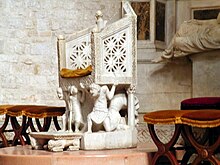Basilica di San Nicola
| Basilica of Saint Nicholas Basilica di San Nicola | ||
|---|---|---|
Year consecrated 1197 | | |
| Status | Active | |
| Location | ||
| Location | Bari, Italy | |
| Geographic coordinates | 41°7′48.94″N 16°52′13.01″E / 41.1302611°N 16.8702806°E | |
| Architecture | ||
| Type | Church | |
| Style | Romanesque | |
| Groundbreaking | 1089 | |
| Completed | 1197 | |

The Pontifical Basilica of Saint Nicholas (
History
The
Architecture

The church has a rather square appearance, seemingly more suited to a castle than to a church. This impression is strengthened by the presence of two low massive towers framing the facade. It was indeed used several times as castle during its history.
The interior has a
In 2012, a set of integrated data from ground-penetrating radar and seismic sonar highlighted the presence of relevant water infiltrations in two areas of the crypt restored in 1950, which may possibly be due to an accumulation of humidity.[1]
Treasures

The Basilica houses one of the most noteworthy

In the church there is a 16th-century Renaissance tomb of Bona Sforza, Queen of Poland, made from marble. The Museum of the Basilica has valuable works of art, including a collection of twelfth-century candelabras donated by King Charles I of Anjou.
The church was restored in the late 13th century, in 1456 and in the 17th century. In the 20th-century restoration, most of the Baroque additions were removed, leaving only the gilded wooden ceiling, enframing canvases by Carlo De Rosa.
Feast days
6 December is
9 May (22 May) is celebrated annually in the Russian Orthodox Church as the feast day of the "Translation of the Relics of Saint Nicholas from Myra to Bari".
Pilgrimages to the basilica from Eastern Europe have increased dramatically since the fall of the Iron Curtain, not only for the feast days, but throughout the year.[citation needed]
See also
- Main sights in Bari
- Cathedral of Acquaviva delle Fonti
- Cathedral of Altamura
- Sanctuary of Monte Sant'Angelo
- St. Nicholas Church, Demre
References
- OCLC 4897885740.
